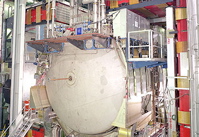What happened after the big bang?
BU physicists search for subatomic answers

In a sense, when particle physicists at Fermilab in Illinois smash together beams of protons and anti-protons in the four-mile long Tevatron particle collider, they are trying to go back in time. By creating energy levels that existed shortly after the big bang, they hope to find evidence of elementary particles that could help solve some long-standing mysteries of how the universe evolved.
One such mystery is how and why certain elementary particles have mass, while others, notably the photon, don’t. Physicists have proposed several theories over the past few decades, yet very little has been resolved. But now, thanks to new data and a more sensitive means of analyzing it, a group of BU physicists working at the Tevatron, led by Meenakshi Narain, a College of Arts and Sciences associate physics professor, think they may soon have the evidence for some long-awaited answers.
First, a wee bit of physics. Currently, there are four forces known to be operating in the universe — the strong force that holds together the nucleus of atoms, the weak force that underlies radioactive decay, the electromagnetic force that binds electrons to nuclei, and gravity. Physicists theorize that at the super-high energies that existed just after the big bang, there was only one, unified fundamental force, and every particle was massless. Then, within a fraction of an instant, “the universe cooled, these forces split, and things got massive,” Narain explains.
While physicists agree on this basic sequence, the standard model of known forces and particles leaves several fundamental questions unresolved, such as the aforementioned mystery of mass. Numerous competing theories have been developed to try to close the gap, each predicting the existence of new subatomic particles.
At places like Fermilab, high-energy collisions are generated 24 hours a day in the hope of spotting the elusive particles that would bolster one theory over the others. While particle accelerators don’t play favorites, CAS Physics Professor Ken Lane has his money on a theory known as “technicolor,” which he helped create in the late 1970s.
Technicolor describes a proposed fifth force that led to particles acquiring mass as the universe cooled. BU researchers have been sifting through huge amounts of particle-collision data from the Tevatron’s DZero detector, searching for the elusive telltale signs of a technicolor particle: the techni-pion. After looking at Tevatron data over several years, however, nary a techni-pion has been spotted. Then again, neither have any of the particles predicted by competing theories. Long story short: no theories confirmed and no theories ruled out.
But there have been a few recent developments that make the BU physicists hopeful that their long experimental limbo may soon be over. For one thing, recent improvements to the Tevatron and its DZero detector will allow the researchers to gather about eight times as much data over the next three years as they collected in the four previous years. This is important, because as powerful as the Tevatron is, it can only generate energy levels sufficient to produce a handful of techni-pions for every trillion collisions.
“Basically, experimental particle physicists have to look under the lamppost that they have,” explains Lane, referring to the Tevatron’s power to reveal new subatomic particles. Thus, having more collisions to analyze increases the probability of finding the elusive particle, if it exists.
Just as important, the BU team now has a much more efficient and sensitive means of sifting through all this new data in search of the predicted particle. They developed a computer program using a mathematical tool called a neural network, which is modeled after the human neural pathways that guide cognition by learning to find patterns amidst a massive amount of sensory information.
The researchers trained the neural network to distinguish a “true techni-pion signal” from false signals they call “background” using thousands of examples and the processing power of computer clusters spread all around the world. In addition, they tested the validity of their computer model to make sure it could, in Narain’s words, “predict what we already know.”
The researchers are now ready to turn this new tool loose on the unknown using the data they began collecting this year. “For the first time, we are getting to the level of sensitivity where in the next few years we can actually either find evidence for technicolor or rule it out, pretty conclusively,” says Narain. Lane, for one, hopes the theory he helped pioneer will be validated. In the data taken in previous rounds of the Tevatron experiments, he noticed persistent, small fluctuations consistent with the presence of a techni-pion, which he describes as “tantalizing.”
No matter what the promise of the new Tevatron data and the neural network technique of data analysis may be, Lane, Narain, and probably every physicist on the planet are eagerly anticipating the start of operations at the 17-mile-long Large Hadron Collider (LHC) at CERN, a particle physics laboratory that straddles the border between Switzerland and France. BU physicists are involved in the creation of the massive detectors that will be used at the LHC when it starts smashing proton beams together in 2008, achieving about seven times the energy of the Tevatron. Indeed, borrowing Lane’s metaphor, the LHC will provide experimental physicists searching for new elementary particles with a much brighter lamppost.
“It will have enough energy to answer a lot of questions,” Lane says.